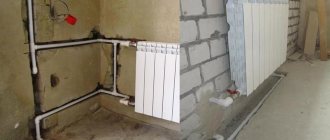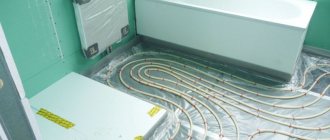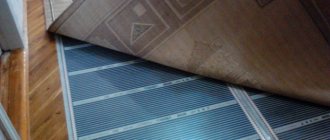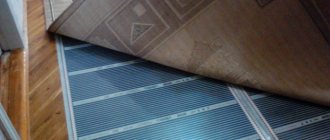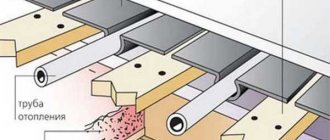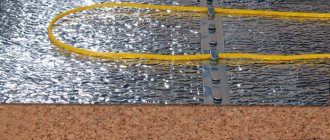Warm floors are used to maintain a comfortable temperature in the rooms. They are used for main room heating or for additional floor heating. Of course, the question arises: in what rooms are such structures installed? Is it possible to use heated floors in the bedroom? To get the answer, it’s worth studying all the pros and cons of such a solution.
Warm floors installed in the bedroom increase comfort
Comparison and classification of heated floors
Among several types of underfloor heating, the most popular are:
- electrical;
- aquatic.
The first insulation option is heated floors using electricity. They are classified into cable, which consist of mats containing rods made of carbon or carbon film, and infrared, which are heated by waves that carry out heat transfer. Their system is not difficult to install.
The next type is a water heated floor. It is based on metal and plastic pipes where hot water flows. The center of the entire structure described is the boiler.
Water floor and its features
Today, all systems are divided into two main types: water and electric. Water is used on a limited budget, as it has a low cost, and the technology has been used for a long time, so it can be called proven. The base of the floor definitely needs high-quality insulation. Next, pipes are installed through which warm water is supplied from the boiler or central heating system. They heat the floor, and the heat from it heats the air. A water floor is a heavy system; it is not recommended to install it yourself
Please note that one of the disadvantages of creating this option for a bedroom is the thickness of the created installation, which can reach 10 cm. This option is considered suboptimal for small bedrooms with low ceilings
If this type of heated floor is installed in an apartment, then permission and approval from the authorities is required, as it can harm your and your neighbors’ property.
The task of choosing heating devices
Each of us wants to arrange a room so that it is pleasant for the family to stay in it. To maintain comfort, you need to choose a specific floor heating device. They all differ from each other, have their own specificity and originality.
Each type of heating considered is different in installation, mode of operation, and cost. Uniqueness also depends on connection to energy sources.
Carrying out installation work
It is important to pay sufficient attention to preparing the foundation for further work. Among the features of installation work, we note the following points:. The base is thoroughly cleaned of debris and dust.
If there are strong differences or cracks, then restoration work should be carried out. Depending on the heat source that will be installed, the thermal insulation material is selected. Its thickness must be at least 3 millimeters. Separate pieces of insulation can be connected with tape. Almost all modern systems have a thermostat. To accommodate it, a special niche is being created. A cable is supplied to the thermostat, as well as grounding. The rise of the thermostat may vary. From the created niche, a groove is punched down, which is designed to accommodate the power cable and its supply to the main part of the system. If a power cable is laid as a heat source, then a reinforcing mesh is used. It is necessary to fix the cable in the required position.
The base is thoroughly cleaned of debris and dust. If there are strong differences or cracks, then restoration work should be carried out. Depending on the heat source that will be installed, the thermal insulation material is selected. Its thickness must be at least 3 millimeters. Separate pieces of insulation can be connected with tape. Almost all modern systems have a thermostat. To accommodate it, a special niche is being created. A cable is supplied to the thermostat, as well as grounding. The rise of the thermostat may vary. From the created niche, a groove is punched down, which is designed to accommodate the power cable and its supply to the main part of the system. If a power cable is laid as a heat source, then a reinforcing mesh is used. It is necessary to fix the cable in the required position.
In addition, when choosing a cable, you should consider the importance of developing a plan for its placement. The layout should take into account the location of large-sized furniture, since this area should not be heated
To simplify the work, lines are drawn on the insulating material using adhesive tape. After marking the floor covering, the power cable is laid. It is worth considering that bending it is not allowed
Fastening is carried out using a special tape or clips. If mats are used, then attention is paid to cutting them - the cables should not be damaged when dividing. The connection of the heating cable with the power and temperature sensor must be carried out exclusively on a flat surface. The connection point should be protected with a corrugated pipe. When connecting, check the cable resistance
The entire system must be connected to a power source during a complete blackout. All elements should be closed with a tie. When doing the work yourself, you can use a cement-based composition. It is worth considering that there is also a special composition on sale, the packaging of which indicates its use after laying the heated floor. The mixture is prepared taking into account the recommendations indicated on the packaging; the thickness of the screed should be approximately 4-5 centimeters. When creating a screed, it is taken into account that it should not have air pockets. When air pockets appear, the heating efficiency of the floor covering is significantly reduced.
The final stage of work consists of laying the floor finishing material. When choosing a lining, keep in mind that some are not designed to withstand high temperatures. This is due to the fact that some may lose their basic performance properties.
In conclusion, we note that creating an electric heated floor is much easier than a water one. Difficulties may lie in connecting the main part of the system to an energy source.
Water-based floor heating
Such a floor requires a long rise in temperature and cooling, in contrast to the electric type of heating. Installation of a water floor is used in private homes. In apartments it is not advisable due to the complexity of the design.
Water transforms the hydraulic heating system of a building, so an imbalance in its structure is possible. This minus can also damage some radiators.
The collector, which is the basis of the heater under study, is subject to rapid breakdown; it has to be replaced every 5 years to avoid leaks and the formation of rust on iron pipes.
The driven heating device can be equipped with a timer that allows you to set the time and a temperature regulator, which contributes to greater comfort.
Is heated flooring really necessary in the kitchen?
In general, it all depends on how well your central heating works and what kind of flooring you have in the kitchen.
If you have a wooden floor, then there is no question of any heating, since this will quickly dry out the wood, which means huge cracks and creaking will appear. Even without heating, wood is a fairly warm material and walking on it barefoot is always good.
Also, we do not recommend that you install warm floors under linoleum. Do not forget that this is a chemical and when heated, such a floor will release phenol, which is completely unhealthy.
In other cases, a warm floor is what you need. And, if your batteries heat very little, this option will be a great alternative to additional heating devices. It ultimately consumes much less electricity, but the heating effect is much better.
Is there a difference between heating a specific and small area of the kitchen with a heater or the whole room at once? Moreover, in this case the heat comes from the very bottom to the top, that is, the heating is uniform, unlike other sources.
When one battery or electric radiator is running, the floor still remains cold, since heat goes exclusively upward, according to the laws of physics.
Electric heated floor
Compared to a water floor, an electric floor is suitable for both private houses and apartments. On the other hand, it dominates in price, due to the fact that there are significant costs of electrical energy.
This is due to the location of the cable - the leading heating element, which is accompanied by grounding and isolation of the electrical movement of charged particles.
After this, the floor is covered with a thick concrete aggregate. To save money, you should install devices that regulate the temperature. If you follow safe instructions, then this type of heating does not pose a danger to the human body.
What types of electric floor heating systems are there?
In this block, let's look at which electric floor is best to choose. There are several types of them and each of them is good in its own way, and we will analyze in which cases one or the other is better.
1. Cable electric floors are, roughly speaking, just shades that are laid out on the floor and need to be covered with a mesh and screed. It is this type that can be equipped with a thermostat, which can be adjusted to any desired heating cycle. Let's say you can set the heating for a week, with turn-on intervals of an hour or two. This saves 50% of energy, which is quite a lot.
2. Rod electric floors - such floors are also called carbon floors, because they consist of, in fact, carbon rods. Such floors are durable, the manufacturer promises 20 or more years of service, but they are more expensive than simple cable ones. The rod floor is suitable for any type of covering and you can safely place heavy furniture on it.
3. Film heated floors - their advantage is that they are extremely thin and do not require screed. They can be laid directly on top of a screed or an old wooden floor, and these sheets can be covered with thin plywood. And only then can you lay Lenoleum or laminate. Such floors are not suitable for tiles.
Warm infrared floor
Should I have a heated floor in the bedroom? It is first necessary to study the structure of the structure. Infrared heating is used to heat the floor structure. Generating heat using infrared waves is a beneficial method.
For reliability, it is assumed to use chipboard. Decorative items can include linoleum, parquet and other decorative coverings.
The principle of operation is based on the penetration of electric current through an aluminum shell fixed in the middle of the insulators. Aluminum has high thermal conductivity, which reduces energy costs.
Reliability and harmlessness of heated floors
A floor with water coolant does not pose a particular threat. However, water leakage may occur during its operation. The connecting parts of the pipeline become unusable over time. Is it possible to make heated floors in the bedroom based on electricity? Despite the simplicity of their assembly, the electrician also needs to take part in the work.
For greater safety, a grounding and insulation process is provided. Cable floors can create a harmful electric field. Infrared heated floors are the most harmless and harmless to humans.
Tips for choosing underfloor heating
How to choose a heated floor for a bedroom? We present to your attention the opinions of experts:
- You should not use electric heating under a wooden plank because it will be subject to deformation when heated;
- In an apartment located on the ground floor and a private house, it is advisable to install water heating, which will be more economical than electric heating;
- There is no possibility of flooding of neighbors;
- In case of major repairs, you can use a water heating system. This will allow for a strong arrangement of pipes that will transfer heat to unheated areas of the room;
- It is not recommended to place infrared film under furniture where there is a possibility of overheating;
- To distribute heat evenly throughout the entire mount, you should use insulation and a reflector on top of it.
Positive and negative sides of heated floors
Of course, you need a warm floor in the bedroom, which has a good effect on the condition of the body. It reduces the chance:
- The appearance of drafts;
- Increases human activity;
- Relieves fatigue, tension, stress. This is especially significant for the bedroom.
The next aspect should be noted that the placement of a warm electric floor is concise, it can only be installed in a certain room and connected to the source at the required time. The disadvantage of this method is its high cost compared to water heating.
A warm water floor is not suitable for those living in multi-storey buildings. Its system produces a complex hydraulic load. In the future, this threatens to flood the neighbors below. Water heating is turned on only with the onset of the heating season and special permits.
Which is safer?
The undeniable advantage of a water heated floor over an electric one is its absolute safety. Although modern cable and film heating systems have a high degree of protection, there is still a possibility of electric shock during operation.
The advantage of a water floor in comparison with an electric one is that you can install a heating system in any room, regardless of its characteristics. And to heat rooms with high humidity using a heating cable, it is necessary to use a special wire with a high degree of protection, which affects its cost.
Parts requiring attention in heating
The following subtitle will discuss all the principles on the issue: “Warm floors in the bedroom: pros and cons.” Positive aspects of water floors:
- absence of an electric field creating radiation;
- safety;
- efficiency;
- possibility of installing temperature regulators.
Their negative sides:
- high costs of installation;
- frequent replacement of fastening systems and iron pipes;
- inappropriate installation in multi-storey buildings;
- leaks.
Advantages of electric heated floors
The advantages and disadvantages of these structures in the sleep and rest area are highlighted. The advantages include:
- not difficult to install;
- long-term functioning;
- easy correction of failed systems;
- installed even in skyscrapers.
Its disadvantages:
- high price;
- short circuits, electric shock due to careless installation;
- radiation.
A heated floor, regardless of its type, will create pleasant sensations, harmony, the necessary warmth and comfort. It will bring comfort to your home. Therefore, everyone can answer this question for themselves: “Is it possible to have heated floors in the bedroom?”
Disadvantages of installing a heated bedroom floor
If the task is “Should I install a heated floor in the bedroom,” then you need to judge based on several options. They include:
Any breakdown requires large-scale repair of the entire system.
There is a gradual heating of the room, which requires quite a bit of time.
You should not use underfloor heating in a room with a low ceiling, since the concrete base is 10 cm.
The work should only be carried out by a qualified worker because installation requires a reliable approach.
To decide on the choice of floor heating, you need to immerse yourself in the full essence of the positive and negative sides.
Water floor and its features
Today, all systems are divided into two main types: water and electric. Water is used on a limited budget, as it has a low cost, and the technology has been used for a long time, so it can be called proven. The base of the floor definitely needs high-quality insulation. Next, pipes are installed through which warm water is supplied from the boiler or central heating system. They heat the floor, and the heat from it heats the air. A water floor is a heavy system; it is not recommended to install it yourself
Please note that one of the disadvantages of creating this option for a bedroom is the thickness of the created installation, which can reach 10 cm. This option is considered suboptimal for small bedrooms with low ceilings
If this type of heated floor is installed in an apartment, then permission and approval from the authorities is required, as it can harm your and your neighbors’ property.
How to design a heated floor?
To design a water heated floor, choose linoleum, tiles, self-leveling coating, which surprises with its beauty and unusualness.
To design an electric floor, non-recessed linoleum, ceramic tiles, self-leveling and laminar coatings are used. Comfortable flooring will ensure good movement in the room.
To ensure better floor heating, you need to choose a coating that has excellent thermal conductivity. When it comes to floor finishing, the most environmentally friendly product is ceramics, which has the ability to retain heat for a long time. However, it is not recommended to install such a floor in a children's bedroom.
Cork
But cork covering will help allergy sufferers feel like completely healthy people.
The bark from which the coating is made is natural and has excellent bactericidal properties. The floor always maintains a comfortable temperature and is very pleasant to the touch.
Thanks to its unique composition, cork has excellent shock-absorbing properties, which helps relieve some of the load from the spine when walking. A fall on such a floor will have fewer consequences, which is why it is often installed in children's bedrooms.
Good sound insulation will be another undoubted advantage of a cork floor.
Maintenance will not be difficult; the material has an excellent antistatic effect, can be easily washed with ordinary water and is not afraid of moisture.
This type of coating will last for a long time without losing its unique qualities.
But cork does not have a very wide range of colors and is expensive. Therefore, it did not take its rightful place in the ranking of floor finishing materials.
When is underfloor heating needed?
It is important to insulate the floor if there are children in the house or apartment, especially those who are still crawling. This will prevent colds during the cold season.
The surface of the heated floor heats up evenly and there are no cold spots left. They have aesthetics in which all elements of the heating system are located under the floor. The interior of the bedroom will not be disturbed and will provide more space for any decorative items.
Evaporation of floor covering substances
According to the laws of physics, the molecules of substances under the influence of elevated temperature are brought into rapid motion, after which they undergo evaporation. The structure of floor insulation includes various plastic materials.
Volatilization of substances occurs only at very high temperatures. The specific heat of evaporation of plastic substances is at a high level, which requires large heat inputs.
The most important thing is that the degree of heating of any floor is limited to 30 degrees. It is minimal in order to expose hazardous substances to evaporation.
Many people are interested in “Why can’t I have a warm floor in the bedroom?” The reason is simple: electromagnetic radiation emitted from the network is harmful to humans, but in this case its degree is not significant. The use of such structures in the recreation area helps prevent seasonal ARVI and the growth of fungal infections on the surface of the walls.
Types of heated floors and their harm to health
Warm floors can be water or electric. The latter, in turn, are divided into cable and infrared.
Video
Is WARM FLOOR harmful to human health and how much will electricity bills increase?
Let's take a closer look at the impact of each design on human health.
Why is water heated floor harmful?
A water heated floor is a device with pipes through which heated coolant moves. The main harm that such systems cause is the possibility of excessive heating of the floor covering up to 30-40°C. In such cases, we cannot talk about any comfort, since it will be very difficult to operate such floors.
In addition, according to doctors, excessive heating can provoke an attack of diseases such as asthma, radiculitis. Blood circulation may also be impaired. But these health problems can also arise when a room is overheated by a conventional radiator.
More often, such overheating is associated with installation errors, which leads to temperature inertia and reduces the service life of floors. In addition, an incorrectly laid structure leads to the formation of condensation .
For your information! It is believed that the circulation of warm air resulting from the operation of a water floor has a detrimental effect on human health. But that's not true!
Malfunctions in the body are caused by incorrectly set temperature conditions.
For people suffering from asthma or having problems with the respiratory system, the harm from the operation of this device is associated with drying out the air, but this applies to all existing heating systems.
If the installation is carried out according to the instructions and without errors, and the operation of warm hydrofloors is carried out without violations, then for a person who does not have chronic diseases, they do not pose a danger, and their use does not have a negative impact on health.
Electric heated floors - harmful to health or not?
For electric heated floors, the heating element is the cable. The system operates on electric current, therefore, like all conductors, it emits electromagnetic waves.
In this regard, the Russian Sanitary and Epidemiological Service conducted a study on the influence of the electromagnetic field on humans, and what harm it causes to health. As a result, it was concluded that the permissible level of constant electromagnetic flux, which does not harm human health, is within the range of 0.2-0.3 µT.
The radiation of electric heated floors with a two-core cable is on average 0.2 µT, which in turn meets sanitary standards. A single-core cable emits electromagnetic waves equal to 2 µT.
Note! The average magnetic flux density of the earth is 50 µT; this level is a natural background and does not negatively affect the human body.
To ensure that there is no or minimal harm from the operation of the cable floor, it is important to choose the right model:
- it must have an ISO 1400 environmental safety standard;
- It is better to purchase a floor that has a two-core shielded cable; it has a metal braid that protects against radiation.
If you are still afraid that electromagnetic waves will harm your health, then do not place them in recreation areas and places where you spend a lot of time.
Are warm infrared floors harmful or not?
Infrared floors are of the electric type and consist of a film with built-in carbon plates. When this device operates, infrared radiation is emitted, which also has its own standards, they are prescribed in SanPiN 2.2.4.548-96.
The myth about the negative impact of infrared waves from heated floors on human health is greatly exaggerated. Of course, the powerful effect of infrared rays on the body is harmful, but in the film its level is minimal, no more than in other household appliances.
The spectrum of infrared waves is different, and is divided into three ranges according to the degree of penetration into the layers of the skin:
- with deep - up to 4 cm;
- only under the top layers - 0.5 cm;
- with maximum penetration up to 0.2 mm.
Infrared film emits all three types of waves. As the temperature increases, the film emits short waves, and as it cools, it emits long waves. If we consider the type of waves from the point of view of safety for the body, then based on the human body temperature, which is considered normal (36.6), we can say that the peak radiation consists of waves measuring 9.6 microns.
Thermal energy equal to this value does not have a negative effect on the body and is considered quite safe. This wavelength range does not penetrate the skin.
Important! When purchasing infrared heated floors, you need to take into account the wave ranges reflected in the specification; experts recommend products with values from 3 to 10 microns.
